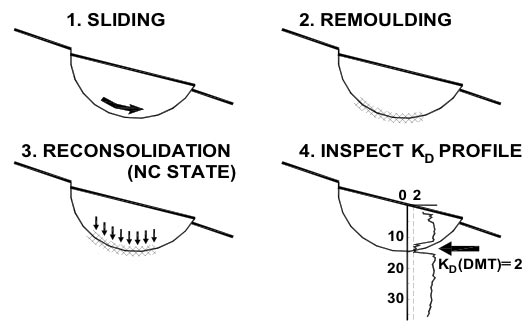Detecting slip surfaces in OC clays slopes
Table of Contents
Add a header to begin generating the table of contents
The KD≈2 Method (Totani et al. 1997) permits to detect active or quiescent slip surfaces in overconsolidated (OC) clay slopes, based on the inspection of the KD profiles. In essence, the method consists in identifying zones of normally consolidated (NC) clay in a slope which, otherwise, exhibits an OC profile. The NC clay bands, remoulded by the sliding, then reconsolidated under the weight of the overlying soil, are recognized by using KD ≈ 2 as the identifier of the NC zones.
Note that the method involves searching for a specific numerical value (KD ≈ 2) rather than for simply weak zones, which could be detected just as easily by other in situ tests. The KD ≈ 2 method permits to detect even quiescent surfaces, which could reactivate e.g. due to a cut.
In the slip surfaces the designer might chose to adopt Øresidual.
The method provides a faster response than inclinometers. The Kd≈2 method can detect quiescent slip surfaces that inclinometers cannot detect. On the other hand the method cannot establish if a slope is currently moving and what the movements are, while inclinometers can. For this reason DMT and inclinometers are often used in combination, with the DMT executed first to optimize the location of the inclinometers.
